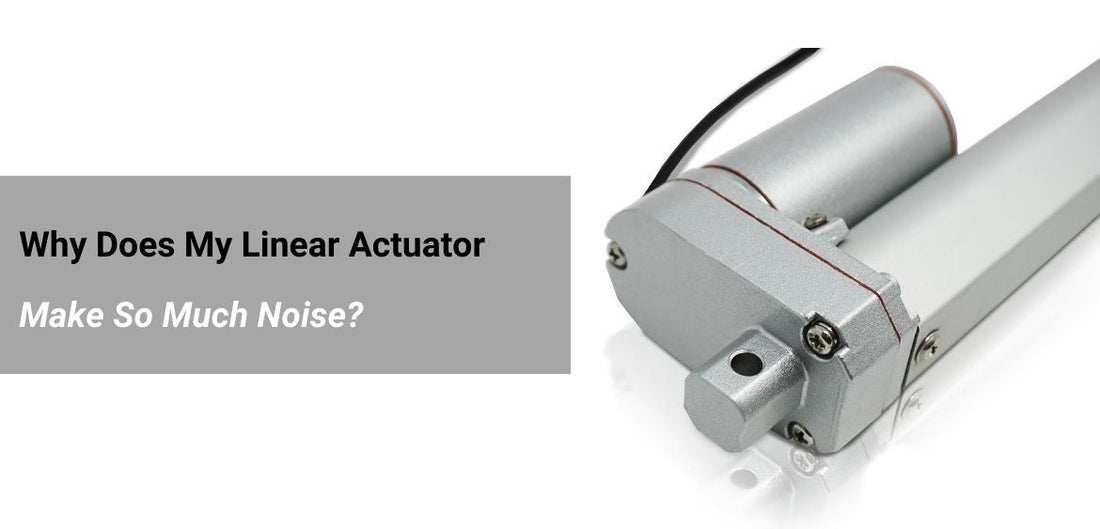Electrical linear actuators are an essential tool in our daily lives, helping to automate several processes. These essential devices can often be integrated within many applications where noise sensitivity could be important, for example in modern medical beds. When looking at the types of actuators you can opt for with noise containment in mind, it is clear that electric actuators are the superior choice. Electric linear actuators emit less noise than pneumatic systems, which is one of the main reasons why electrical actuators have been edging out pneumatics in many areas (including medical facilities).
With this in mind, we posed the question: aside from their superiority over pneumatic systems, what can make a linear actuator sound differently or operate louder than usual? Excessive noise is a difficult issue to address as there is likely no single source of the problem. This article is going to present some of the most common causes of excessive noise in linear actuators.
Imperfections of the Lead Screw & Drive Nut Tolerance
This issue is characterized by periodic mechanical noise that occurs when the actuator is moving. Usually, the noise is more noticeable under heavy loads, which is attributed to the lead screw and nut not mating well. If the lead screw and nut are too loose, this could cause vibrations as the motor moves and on the other hand, if the lead screw and nut are too tight, you will have extra noise and a drop in speed due to friction. Below we have included two videos: one showing the drive nut and lead screw functioning normally and the second demonstrating the effect if they are too tight.
Drive nut and lead screw spacing too tight
Drive nut and lead screw functioning normally
If your suspicions is that the drive nut and lead screw spacing is too tight, this can be tested by taking the unit apart and turning the nut. Turning the nut should cause it to rotate around the lead screw and move forward. If there is excessive resistance or if turning the nut actually turns the lead screw, there is likely a noise problem as the friction is too high. This is a manufacturing issue since you either have a defective nut or a damaged lead screw. This issue should be covered by manufacturing warranty, but you may be able to resolve it by replacing the drive nut.
Motor Stator Issues
The motor is held between two bearings. If the bearings are loose in their sockets, the movement of the motor will cause vibrations. These vibrations could result in more noise in the gearbox due to rotor gear spacing, or just whining within the motor itself. Loose bearings can even lead to excessive current problems if they get stuck in a position that causes the motor to compensate for extra torque. The below images show a bearing stuck to the shaft of the rotor instead of sitting tightly in its socket.

The below two videos depict the drive nut being easily turned in normal operation, with the second video showing when this mechanism is harder after switching to a non-conforming stator.
Normal operation - drive nut easy to turn
Drive nut is harder to turn after switching to the non-conforming stator
To definitively test if this is the case, a method to verify is manually rotating the lead screw, as per the second video. Rotating the lead screw would cause the rotor to move and ideally, the bearings should allow it to move freely. However, if there is an issue with excessive wear of the bearings or misalignment, the lead screw will be difficult to turn. This issue may be resolved by putting the bearings back inside their sockets and ensuring that they are completely flat. That being said, it will likely cause a problem again, so it is best to replace the bearings completely. Sometimes this issue can also occur simply because the actuator is getting old, so it may be best to replace the whole actuator.
Gearbox Noise: Tooth Spacing & Shaft Alignment
If the gears inside the gearbox are not making proper contact, they can cause excessive noise. This is likely the most common cause for excessive metal gear noise. Under normal operation, gears are supposed to slide into each other with adequate lubrication. If the gears are too close, there is excessive friction and they may seize or scrape against each other. While this would lead to much quieter and smoother operation, it would also wear and tear on the gears and potentially gear binding.

Alternatively, the distance between the gears may be too large. In this case, the gear backlash will create a lot of noise and the operation won’t be smooth. The noise level is extremely sensitive to the distance between gears, which leaves us with a relatively small room for error.
Gear spacing sensitivity example/illustration
The gear spacing requirements could be violated due to manufacturing tolerances of the gears - both mating gears could be on the small end of the spectrum and not engage properly. It could also be possible that, for a variety of reasons, the rotor itself is a little tilted, which would affect the gear gap.
You may be able to resolve the issue by purchasing a new set of replacement gears. It is also possible to check the bearings on the rotor – if they are misaligned, the gear gap could be larger. If the source of the noise is the gear spacing, then it is likely a manufacturing issue. In that case, you need to check if the noise is outside the specifications and if it is – replaces the actuator.
Insufficient Grease in the Gearbox
Gear lubrication in an enclosed gearbox with relatively low speed, such as in an actuator, is typically done with grease instead of oil. If there is not enough grease on the gears, the mechanical friction will be too high and the gears will not only produce more noise, they will also wear out much faster. Insufficient grease is a manufacturing issue – there should generally be enough inside the gearbox to last the lifetime of the actuator. Insufficient lubrication inside the gearbox will also cause vibration and can make the gears overheat.
Fortunately, this is one of the issues that is easy to resolve. You can add grease to the gears to fix the problem or potentially distribute the grease already inside the gearbox more evenly and efficiently. If there is no grease for some reason, you can ask the manufacturer which grease to use and fix the problem.

Conclusion
Linear actuators are usually chosen as a lower noise alternative to hydraulic and pneumatic actuators. That being said, electric actuators can still be quite loud for a number of reasons, with the most common listed above. It is important to pay attention to the noise coming out of the actuators during operation as this noise could be the sound of a faulty actuator and indicate a serious manufacturing issue. This early action can save you troubleshooting time in the future. Unfortunately, in most cases the excessive noise can’t be resolved without replacing the damaged parts or even the whole actuator.
If your linear actuator sound is irregular and making excessive noise, it would be a good idea to investigate and repair/replace the damaged components. Alternatively, contact us and our engineers will be delighted to help solve this issue.




